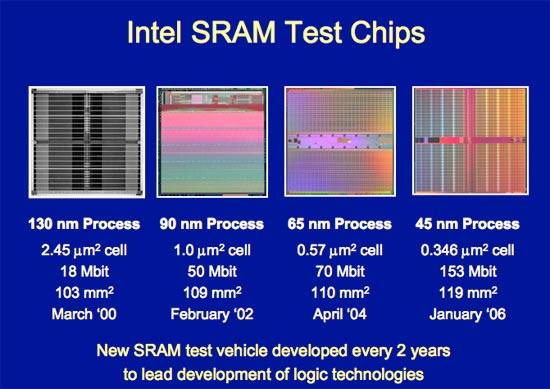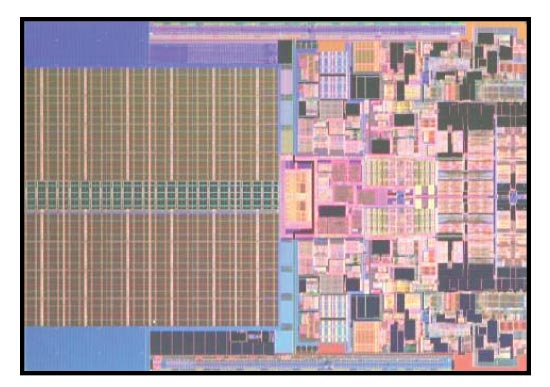Intel Demonstrates new 45nm Transistors and Conroe's Successor
by Anand Lal Shimpi on January 27, 2007 12:00 AM EST- Posted in
- CPUs
Conroe has a Son: Introducing Penryn
Intel announced the first working high-k + metal gate transistors back in 2003. By 2006 it had built an SRAM test vehicle (a wafer full of nothing but cache and some control/test logic) using the new transistors to work out most of the kinks in the manufacturing process.

Today, Intel is announcing that its first full CPU built using the new 45nm high-k + metal gate transistors is not only up and running, but it has also booted four OSes. The very first packaged Penryn silicon from the very first wafer booted Windows Vista, Mac OS X, Windows XP and Linux on the first try.
The picture below is of Intel's validation team after they successfully booted Penryn on the above OSes. The chips arrived in the lab at around 1AM and by 3AM they were up and running. If you're concerned, that's sparkling cider in those glasses and not champagne; alcohol is not allowed on Intel's campus, as it tends not to bring out the best in CPU designs, although it does make benchmark scores look infinitely higher.

It's a fairly big accomplishment to have first silicon working this well, but Intel has had a number of successful first spins in recent history. Generally by the time you're making your first CPUs, you've got the majority of the manufacturing defects worked out thanks to your SRAM test vehicle, so any problems with the first silicon are usually due to errors in the design or in the masks.
Intel also proudly sent us a shot of the 45nm Penryn die:

This version of Penryn is dual-core, and the first quad-core Penryn chips will simply be two of these on a single package, although later on we may see a single-die solution. At 410 million transistors, we expect a dual-core Penryn to have a 6MB shared L2 cache (up from 4MB in Conroe). The logic part of the Penryn core will be mostly evolutionary from Conroe, but do expect additional functionality and performance from more than just a larger cache.
If we assume that 288M transistors (6T SRAM) will be used by the 6MB cache, that leaves 122M transistors for L1 cache and the rest of the core. Applying the same calculation to Conroe gives us 99M transistors left over, meaning that there are roughly 23% more core-logic, control and L1 transistors being used in Penryn than in Conroe.

What that additional functionality will be is up in the air at this point, but you can expect SSE4 support to occupy a chunk of those transistors. At 45nm Intel should also be able to ramp up clock speed, so expect to see Penryn debut at over 3GHz easily. Given how overclockable Conroe turned out to be, we wouldn't be too surprised to see Penryn scale very well.
And the last bit of Penryn information Intel is letting out today is that it demonstrated Penryn up and running actual applications at a press briefing in Santa Clara on January 25th. There were five Penryn systems configured and clocked as follows:
1) 45nm dual core mobile processor in a notebook with Microsoft Vista running Microsoft Office 2003 applications.
2) 45nm dual-core desktop processor running high definition video content (1080P) under Microsoft Vista. 2.13 GHz
3) 45nm quad-core desktop processor running Ubisoft Rainbow Six Las Vegas game under Microsoft Vista. 1.86 GHz
4) Two 45nm dual-core processors running Glaze Workstation application under Microsoft Windows 2000 Advanced Server. 2.13 GHz
5) Two 45nm quad-core processors encoding a video in Adobe Premier under Microsoft Vista. 2.13 GHz
All of the systems were air-cooled using normal heatsink/fan units. Unfortunately Intel wouldn't share any benchmarks or more details of the systems other than what software they were running.
At this stage in the game it's normal to see clock speeds much lower than final shipping silicon, but this is the first time that Intel has been so forthcoming with clock speed data this far before launch. What we're seeing is a far more proud and confident Intel, and honestly it has every reason to be given the recent successes of Core 2 and promise of Penryn.










59 Comments
View All Comments
Viditor - Tuesday, January 30, 2007 - link
It's amazing the number of people who have said that since Conroe was introduced...
In point of fact, Intel has dropped over the last year...
Frankly, neither Intel nor AMD will be making much headway while there's a price war on, though AMD will probably regain their losses in the second half of the year.
Intel shares should be close to what they are now in a year (unless of course AMD has a terrorist attack) because (as they guided) their Gross Margins aren't expected to rise at all over the next year.
blackbrrd - Tuesday, January 30, 2007 - link
Actually Intel released the Core 2 Duo around Jul. 2006. At the time a share was worth around 18$ The current value on an Intel share is roughly 21$ (Jan. 30th 2007). In other words an increase of about 16% since they released the Core 2 Duo.Viditor - Tuesday, January 30, 2007 - link
Most of that was seasonality...At the beginning of 2006, Intel was $25.05...so year-on-year (and in a year that Intel released and had 6 months of Conroe), Intel dropped ~20%...
The key point is that while technology is important, Gross Margins are far MORE important!
BladeVenom - Saturday, January 27, 2007 - link
I wouldn't be so bullish on Intel until you've seen AMD's next chip.bamacre - Saturday, January 27, 2007 - link
I'm not worried about it. Intel is serious about being the performance leader right now. They know they have made mistakes, and they know what they have to do to keep the crown. And they also have the tools to keep it. Whatever AMD comes out with, Intel will counter. Just watch.Slappi - Saturday, January 27, 2007 - link
Wow 125%? You must of mortgaged your house and bought Jan 2009 calls then with all your money.Market Cap of 250-300 billion dollars for a company with falling margins, losing market share and estimates of 1.20-1.30 for 2007. That would give them a PE of 32 for a company in the middle of a price war.
I don't think so.
I wouldn't short or buy INTEL at this point. No Way. Too unpredictable right now. 35 to 45 within a year? Even if AMD went bankrupt and closed its doors I doubt you would see 45 in 12 months.
I would however buy AMD and sell CCs on em around 17-18. R600 K8L should do them for around 18 in the next 6 months. You could make good money selling calls 10% out for a few months.
bamacre - Sunday, January 28, 2007 - link
"falling margins, losing market share "That is changing as I type.
hubajube - Monday, January 29, 2007 - link
No it's not. He's spot on.yyrkoon - Saturday, January 27, 2007 - link
Spoken like a true, disgruntled AMD fan boi. (or 'person' if you like). When will you guys learn, it doesn't matter WHO makes the 'best' CPU, and that close competition means win, win, for whoever, using whatever.JumpingJack - Sunday, January 28, 2007 - link
Yep, don't like one bit do they ---- hey, lets compare the OC of a 65 nm AMD chip to the OC of an Intel 65 nm chip ....
Intel has removed the major stumbling block for device scaling that has plagued both 90 and 65 nm.... it only get's better from here.